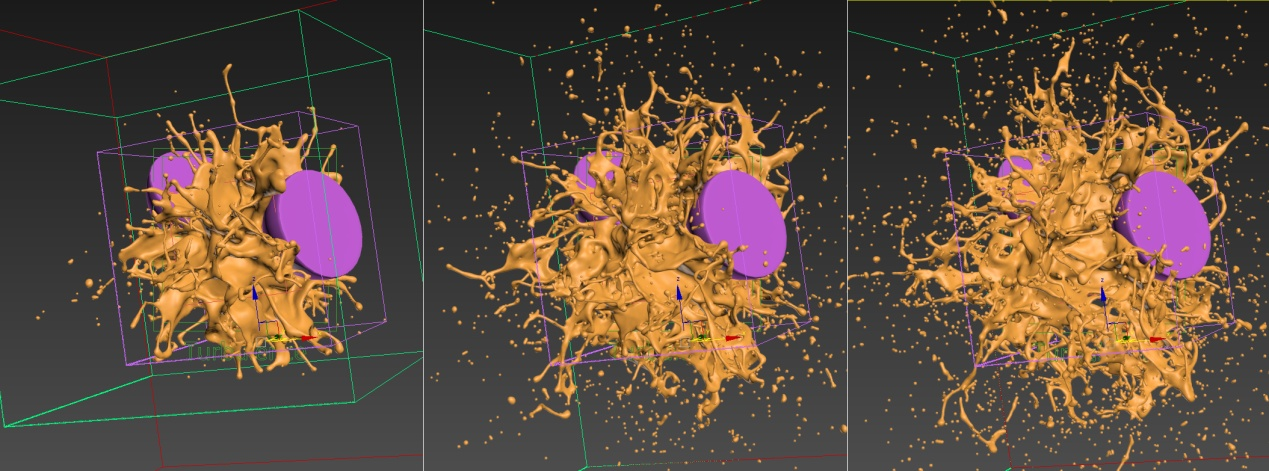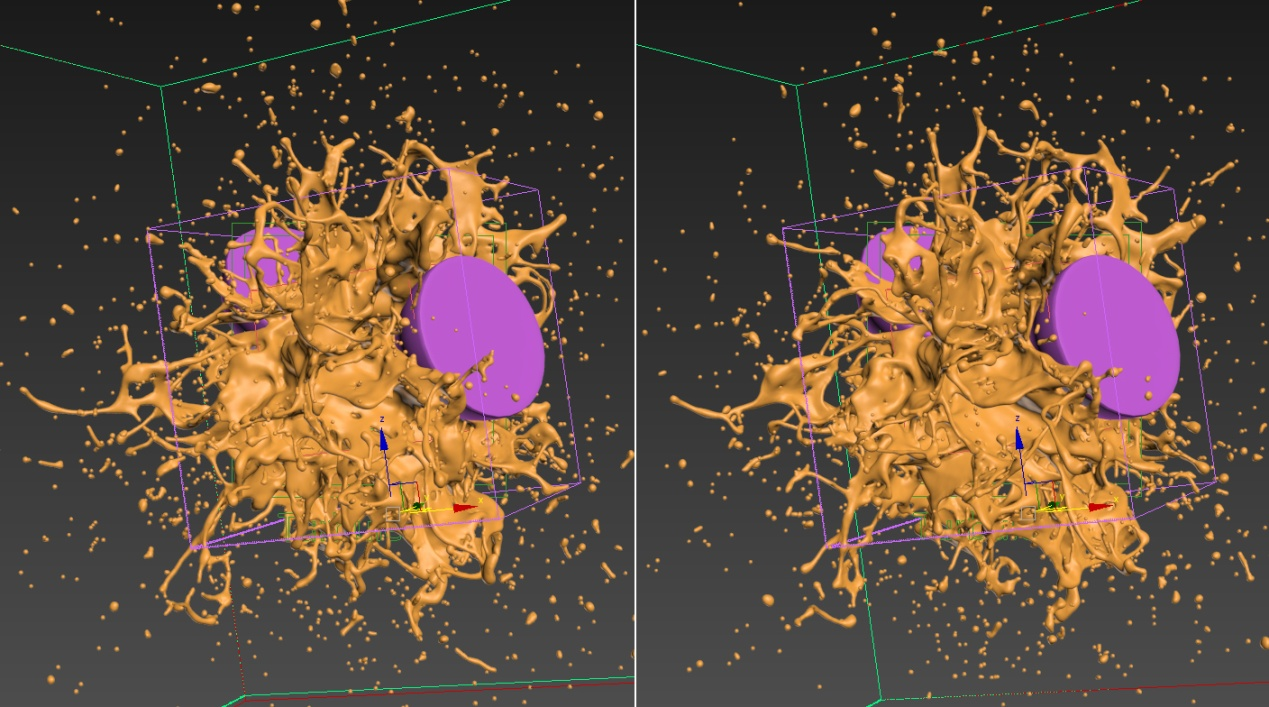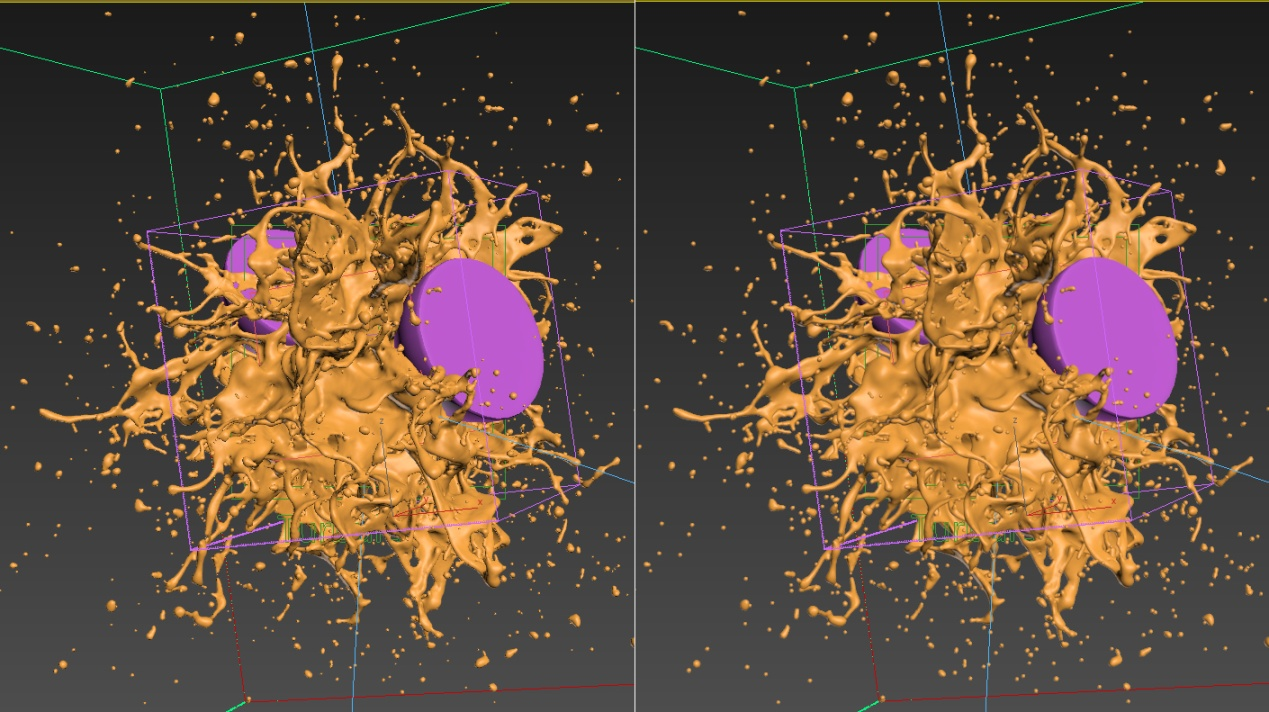This page provides a tutorial on creating a simulation of an exploding orange.
Overview
Many juice advertisements use the fruit exploding effect in still images and animation. In this tutorial, you will learn how to make this liquid exploding effect with Phoenix FD.
We will guide you through the fluid simulation itself and show how to use the Pheonix FD Turbulence force to make the liquid burst out.
We will also show you how different parameters' values (such as Scene Scale, Time Scale, Steps per Frame and others ) give significantly different simulation results, so that you know how to use them in your own simulations.
This is an Intermediate Level tutorial. Even though no previous knowledge of Phoenix FD is required to follow along, re-purposing the setup shown here to another shot may require a deeper understanding of the host platform's tools, and some modifications of the simulation settings.
Units Setup
Scale is crucial for the behavior of any simulation. The real-world size of the Simulator in units is important for the simulation dynamics. Large-scale simulations appear to move more slowly, while mid-to-small scale simulations have lots of vigorous movement. When you create your Simulator, you must check the Grid rollout where the real-world extents of the Simulator are shown. If the size of the Simulator in the scene cannot be changed, you can cheat the solver into working as if the scale is larger or smaller by changing the Scene Scale option in the Grid rollout.
The Phoenix FD solver is not affected by how you choose to view the Display Unit Scale - it is just a matter of convenience.
In this scene, we work in centimeters.
Go to Customize > Units Setup and set the Display Unit Scale to Metric Centimeters.
Also, set the System Units such that 1 Unit equals 1 Centimeter.
Source Geometry
Let's start by creating a Geosphere geometry. It will be the only source in the scene for this tutorial. Set its raduis to 5.0 cm.
The Geosphere is used only to generate liquid and we don't want it visible in the render view. To achieve that, right-click on the sphere and select Object Properties. Enable Display as Box and disable Renderable options.
Then, right-click again the sphere and select PhoenixFD Properties. We want the ball to be filled with liquid at the very beginning of the simulation, so enable the Initial Liquid Fill to secure that.
Force
We enter the most critical step of the preparation. Add a PhoenixFD Turbulence force into the scene. Then, let's set some keyframes to play with the Strength and the Size parameters.
Set the value of Size to 5.0 cm for frame number one. After five frames increase the value to 30 cm. The ultimate goal here is to have the orange juice exploding with lots of detail at the beginning of the simulation, and while the simulation continues, to get less and less of a detail.
Same gradient behaviour is desired for the Strength parameter, but in opposite direction. At the beginning of the simulation we expect a quick explosion that won't persist. So, over time decrease the Strength of the turbulence.
From frame 0 to frame 5 increase the Size turbulence from 5 to 30.
From frame 0 to frame 5 decrease the Strength turbulence from 1500 to 0.
PhoenixFD Simulator
Simulation Grid
Let's move on to creating the simulation grid for the orange juice. Create a Liquid Simulator that encompasses the area around the Geosphere.
For this tutorial we have used the following X, Y, Z values - 171, 156, 171.
Enable Adaptive Grid and expand the boundary as shown in red. Using Adaptive Grid can effectively reduce your simulation time.
Don't forget to enable Maximum Expansion.
Scene Scale
It's time to set the Scene scale.
The image shows three different Scene Scale setups. From left to right those have the following values: 0.1; 0.5; 1.0.
There is no big visual difference in the outcome, so pick one of your choice. In this tutorial, we use the value of 0.1.
Dynamics
Go to the Dynamics rollout.
Make sure to disable the Gravity option, since we don't want the liquid to actually fall down.
Take a look at the other parameters in this rollout. For ease, here are the set values:
Steps per Frame is set to 2. In the comparison example you can see how dramatic SPF is affecting the liquid mesh. The default value of 1 makes the liquid too diffuse.See a comparison image for the Steps per Frame parameter.
Time Scale is set to 0.9. Note that, the smaller the Time Scale, the slower the movement of the liquid will be. It also affects the so called "sticky look". See the comparison Time scale example below.
Viscosity is set to 0.01. See a comparison example of Viscosity below.
Surface Tension Strength controls the force produced by the curvature of the liquid surface.
Droplet Breakup controls the balance between tendrils or droplets formed by the liquid.
Droplet Radius controls the radius of the droplets formed by the Droplet Breakup parameter.
See the result of experimenting with those Surface Tension parameters below. In this tutorial we use the balanced values of 1.0 for Droplet Breakup and Strength and 2.5 for Droplet Raduis.
From left to right the Time Scale parameter is set to: 0.7, 0.9, 1.0.
Left image has SPF set to 1 and the right image has SPF set to 2.
Left image has Viscosity set to 0 and the right image has a value of 1.
Left image: Strength, Droplet Breakup, Droplet Radius are set to 0.0, 0.0 and 2.5. In the middle they have the values of 1.0, 0.0, 2.5. On the right the values are 1.0, 1.0 and 2.5.
Output
Open the Output rollout.
Make sure to enable the Velocity option from the Output Grid Channels panel. It is useful if you want to use Motion Blur during rendering.
Preview
Go to the Preview rollout.
Enable the Show Mesh option. This will display the liquid mesh directly in the viewport.
Rendering
In the Rendering rollout we tweak the Motion Blur's Multiplier so to make the final effect more subtle.
Enable the Use Liquid Particles option. This is a sophisticated method to use the liquid particles from the simulation for smoothing the liquid mesh. When turned off, the mesh shows uniform thickness, which is less realistic. See the example below showing how the simulation looks with and without this option enabled. There is a very subtle difference.
Smoothness
Let's take a look at how the Smoothness parameter affects the whole simulation.
On the left, you see a simulation with Smoothness set to 0. On the right-hand side Smoothness is increased to 20.
Notice how a value of 20 can significantly reduce the banding that is usually seen in grid simulations.
Liquid Particles checkbox is disabled on the left. On the right, the checkbox is enabled.
Material
In order to get a realistic looking orange juice, you generally will need to go through a lot of testing and fine adjustments of the material.
But we have you backed up! In this tutorial we use VRayMtl with the settings from the image.
Feel free to experiment until you find the best fit for your orange juice. But be aware that the right lights play a vitale role in a good-looking render.
Lights
We move on to adding Lights to our scene.
There is a V-Ray Dome light set as an environment light. Aside from it, there are three V-Ray Plane Lights - one on top, one on the side, and one at the bottom. See the lights setup for better locating them in the scene.
The size and intensity of each light are shown here.
Each light is using a GradientRamp as a mask, so that the light is more natural and soft. See its parameters in the example below.
Scene Lights Setup
GradientRamp Texture
Camera
Here is a suggestion of how to set up a Physical Camera for this scene.
Enable both Depth of Field and Motion Blur for more realistic view.
Feel free to adjust those parameters in a way they work best for you.
V-Ray Frame Buffer
Here is how the final render looks like.
Despite the right exposure and light, we can further tweak the render directly from the V-Ray Frame Buffer. Use the Color Corrections panel to finely tune your photo-realistic orange explosion. We have marked with red the parameters that are adjusted in this image. Note that there is a LUT file added to emphasize on the orange's vivid color.







